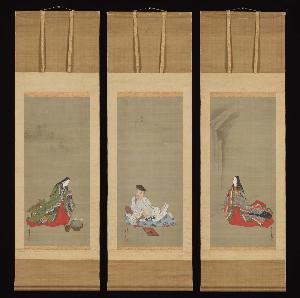Tosa Mitsuoki
Tosa Mitsuoki
Style: Yamato E;
Place: Sakai
Born: 1617
Death: 1691
Biography:
Tosa Mitsuoki, a renowned Japanese painter, was born on November 21, 1617, and passed away on November 14, 1691. He succeeded his father, Tosa Mitsunori, as the head of the Tosa school, bringing the school to Kyoto after around 50 years in Sakai. Mitsuoki's artistic style deviated from traditional Tosa style, incorporating influences from Chinese paintings and echoing stylistic choices of the Kanō School. This deviation granted him a wider audience appeal to the changing art tastes of the imperial court.
Restoring the Tosa School
In 1634, Mitsuoki relocated from Sakai to Kyoto at the behest of Emperor Go-Mizunoo. His father, Tosa Mitsunori, began painting ceremonial fans for the court. In 1654, Mitsuoki succeeded his father and was elevated to the title of edokoro azukari, "head of the Imperial court painting bureau". The Tosa school prospered throughout the Edo period, with Mitsuoki's descendants succeeding him in his role. However, this lack of innovation led to a gradual disinterest in the family's work and its eventual decline in the 19th century.
The Art Workshop
The Tosa school was a closely guarded secret, traditionally passed down orally or in short written documents from master to student. The court and political affiliated art school practices of historical Japan were far different from their contemporary counterparts in Europe and America, but more akin to a family craft or workshop. Many practices flourished during the Edo period, imploring different understandings of Japanese customs and Chinese artistic learning.
Notable Works and Legacy
Mitsuoki's painting style was characterized by "areas of flat opaque color enclosed by simple outlines, where drawing is precise and conventional". His works can be found in various museums, including the Nagoya City Art Museum. Some notable artists who followed in Mitsuoki's footsteps include Tosa Mitsunari and Tanaka Totsugen. For more information on Tosa Mitsuoki and his works, visit the Tosa Mitsunori or the Kanō School.
- Tosa Mitsuoki's contributions to Japanese art can be seen in his elegant and refined paintings, such as Egrets and Cotton Roses, which is a beautiful example of Japanese art from the 17th century.
- His painting style was influenced by Chinese paintings and echoed stylistic choices of the Kanō School.
- Mitsuoki's descendants succeeded him in his role as edokoro azukari, but the lack of innovation led to a gradual decline in the family's work.
- For more information on Tosa Mitsuoki and his works, visit the Tosa Mitsunori or the edokoro azukari.
legacy can be seen in his beautiful and elegant paintings, which continue to inspire artists today. His contributions to Japanese art are immeasurable, and his works remain a testament to the elegance and refinement of Japanese painting.







